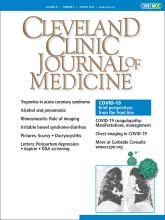Article Figures & Data
Tables
Setting Patients with risk factors for resistant gram-negative organisms Patients without risk factors Outpatient A respiratory fluoroquinolone (moxifloxacin, gemifloxacin, or levofloxacin), or
A beta-lactam (high-dose amoxicillin or amoxicillin-clavulanate, or ceftriaxone, cefpodoxime, cefuroxime) plus a macrolide (azithromycin, clarithromycin, or erythromycin)
Doxycycline can be an alternative to a macrolideA macrolide (azithromycin, clarithromycin, or erythromycin), or
Doxycycline, or
AmoxicillinInpatient, not in intensive care An antipneumococcal, antipseudomonal beta-lactam (eg, piperacillin-tazobactam) plus either ciprofloxacin or levofloxacin, or
An antipneumococcal, antipseudomonal beta-lactam plus an aminoglycoside and azithromycin, or
An antipneumococcal, antipseudomonal beta-lactam plus an aminoglycoside and an antipneumococcal fluoroquinolone
For penicillin-allergic patients, substitute aztreonam for the beta-lactamA respiratory fluoroquinolone, or
A beta-lactam (cefotaxime, ceftriaxone, ampicillin, or ertapenem) plus a macrolide
Doxycycline can be an alternative to macrolide
A respiratory fluoroquinolone should be used for penicillin-allergic patientsIntensive care An antipneumococcal, antipseudomonal beta- lactam plus either ciprofloxacin or levofloxacin, or
An antipneumococcal, antipseudomonal beta-lactam plus an aminoglycoside and azithromycin, or
An antipneumococcal, antipseudomonal beta-lactam plus an aminoglycoside and an antipneumococcal fluoroquinolone
For penicillin-allergic patients, substitute aztreonam for the beta-lactamA beta-lactam (cefotaxime, ceftriaxone, or ampicillin-sulbactam) plus either azithromycin or a fluoroquinolone
For penicillin-allergic patients, a respiratory fluoroquinolone and aztreonamBased on information in references 1, 27, and 28.
- TABLE 2
Studies finding a higher prevalence of oropharyngeal colonization with gram-negative organisms in people with alcohol use disorder
Study Population Findings Dao et al,32 2014 613 men, rural Vietnam Klebsiella pneumoniae was the most common gram-negative organism, isolated in the nasopharynx in 28%
K pneumoniae was found in 23% of light drinkers, 30% of moderate drinkers, and 34% of heavy drinkers
Weekly alcohol consumption was associated with K pneumoniae oropharyngeal carriage (OR 1.7; 95% CI 1.04–2.8)Mackowiak et al,31 1978 124 people with AUD and 84 controls, Dallas, TX Colonization with gram-negative bacilli in 35% of those with AUD vs 18% of controls
Of those with AUD who had gram-negative colonization, 33% had Enterobacter species and 23% had Escherichia coliFuxench-Lopez et al,33 1978 34 with AUD and 28 controls, Puerto Rico Gram-negative colonization in 59% of those with AUD and 14% of controls
Among AUD samples, K pneumoniae accounted for 40% of the pharyngeal secretions and 76% of the isolates were in the Klebsiella-Enterobacter group of organismsGolin et al,34 1998 58 with AUD and 59 controls, Brazil Gram-negative organisms in 49% of those with AUD and 40% of controls
Anaerobic microbes were present in 85% of those with AUD vs 31% of controlsAUD = alcohol use disorder
- TABLE 3
Prevalence of gram-negative organisms in pneumonia patients with or without alcohol use disorder
Study No. of patients, location Gram-negative organisms With AUD Without AUD Gram-positive organisms With AUD Without AUD Fernández-Solá et al,16 1995 50, Barcelona Gram-negative bacilli 19% 0a Streptococcus pneumoniae 6% 6% Marik,39 2000 148, United States and Canada Pseudomonas aeruginosa and Acinetobacter species 22% 5%a Arancibia et al,38 2002 559, Barcelona Gram-negative bacilli 11% 11% Paganin et al,37 2004 112, Réunion Island Klebsiella pneumoniae 30% 10%a Saitz et al,4 1997 23,198, Massachusetts Haemophilus influenzae
Gram-negative bacilli5%
2.5%3.5%a
4%S pneumoniae
Staphylococcus sp.15%
3%6%a
2%de Roux et al,2 2006 1,347, Europe Gram-negative bacilli
Pseudomonas aeruginosa
H influenzae9%
5%
2%11%
3%
4%S pneumoniae 27% 16%a Gupta et al,18 2019 137,496, United States Escherichia coli
K pneumoniae
P aeruginosa7%
6%
1%10%a
7%a
1%S pneumoniae
Staphylococcus aureus6%
4%2%a
3%↵a Statistically significant (P < .05).
AUD = alcohol use disorder






